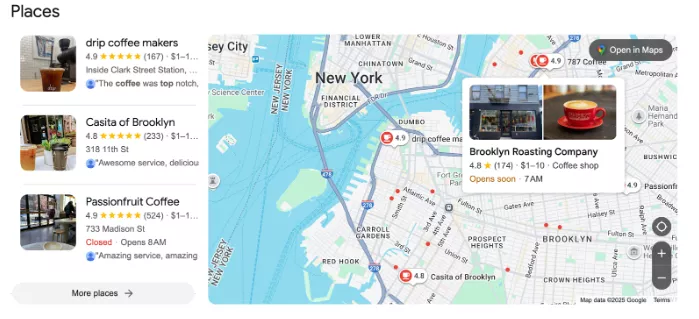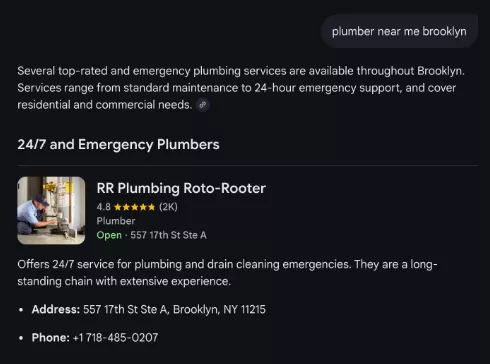Let’s be real — selling online today, it’s not a birthday cake. Over 34 million small businesses are fighting for every bit of attention, and most of them are running in circles chasing one-time buyers. Exhausting, right? Your only hope is local SEO.
People in your neighborhood are like proper hobbits, who hate traveling far away from home. They want the closest coffee shop, the nearest bakery, and a plumber who can show up today — not someone 100 miles away. So, you need to win their hearts and make them come back again and again.
Let’s learn how local Search Engine Optimization supports you in this task. And how it helps to attract more foot traffic and boost sales in the long run.
What Is Local SEO: Cheat Codes for Small Businesses
Most people are homebodies at heart. Why experience the crowded, sweaty, exhausting chaos of city traffic when you don't have to? We want to cover our needs nearby — to support local businesses and avoid the hassle of going to the manicurist in another part of the city.
That’s where location-based SEO comes in. It puts your business on the map — literally — telling Google, “Hey, we're working right here, serving real people nearby.” And it brings money because nearly 46% of all Google searches have local intent (like “brunch near me”).
Almost half of your potential customers are looking for you in their area. It’s a little bit stupid not to show up. It’s like shooting yourself in the foot, losing already hungry visitors, calls, and loyal customers to the competitors.
Local SEO vs Standard SEO Battle
Don’t get us wrong, we love standard SEO. It’s big, powerful, and can make the entire digital world notice you. It’s great for companies with huge budgets, or when you sell something, people can order nationwide.
But you’re competing with everyone and everywhere for first place in Google results. It's harmful to some companies:
-
Local service businesses (e.g., hair salons, cafes). Standard SEO targets broad keywords (“best coffee”) instead of local intent (“coffee in Brooklyn”). It attracts irrelevant traffic from outside the service area.
-
Seasonal or region-dependent businesses (e.g., ski resorts, farms, tour operators). Standard SEO focuses on evergreen visibility, not seasonality or geographic interest. Absence of regional SEO can attract off-season or non-local audiences.
-
Niche local trades (e.g., roofers, electricians, notaries). National traffic won't convert if users can't hire them in person. It's just a waste of marketing budget.
Sometimes, you don't need to impress the whole internet; just your neighbors, who will try your croissants and then come back every Saturday.
Money, Please: How Local SEO Boosts Your Bottom Line
Some people in your neighborhood are already looking for what you offer. Local SEO helps them spend their money with you, not with Starbucks down the street.
Here are some other reasons why local SEO matters for your business:
-
Higher conversion rates: Local searches usually come from people who are ready to buy. They aren't "just browsing" — they want to fulfill their need.
-
Builds community trust: Showing up in local results and on Google Maps makes you feel like a reliable neighbor, shows that you’re legit.
-
Fewer competitors, more visibility: You’re fighting just for your local area. So, it’s easier (and cheaper) to stand out.
Here is a real-life example: we helped a logistics company in the moving sector with local SEO. They increased their traffic by 37% year over year. Sounds great, right? Call us if you want impressive results for yourself.
How to Deserve the Spotlight
Why do some businesses appear when someone searches “best bakery near me,” while others don't? Because they’re Google’s favorites, and search engines trust them.
To become the teacher's pet yourself, you need to prove to Google that you’re legitimate. Here are some ranking factors you should keep in mind:
|
Ranking Factor |
Why It Matters? |
|
|
1. |
Google Business Profile (GBP) |
You add your address, hours, photos, and reviews to it, and tell Google (and customers) you’re a trustworthy local business. |
|
2. |
Local Keywords |
They help to show up your location (“coffee shop in Florida”, “LA pet grooming”) and attract ready-to-buy customers (“fast pizza delivery near me”). |
|
3. |
Proximity |
The closer you are to the person searching, the better. Google loves recommending nearby places. |
|
4. |
Reviews and Ratings |
Good reviews are like the hero ballads sung in medieval pubs — they spread your reputation fast. The more positive reviews you have, the higher you rank. |
|
5. |
High Relevance |
If your profile and website clearly describe what you do (“fresh bread,” “hobbit-sized breakfasts”), you’ll appear for the right searches and make Google happy. |
|
6. |
Online Mentions (Citations) |
If your business name, address, and phone number show up the same across local websites, it proves you’re a trustworthy guy. |
|
7. |
Website Optimization |
Update your website content to include your location — add the phrase “bakery in LA” on the main page, etc. Then, Google will know where to place you on the map. |
A high rank for local searches is possible if you prove to Google that your business is real and has won people's hearts. This allows Google to show relevant information and do its job well. They hate being wrong and have a huge straight-A complex, you know?
What Local SEO Looks Like on Screen
Imagine a hungry office worker types "business lunch near me," and your cozy cafe happens to be nearby.
You did everything you could to be visible in local search results, and now that tired Google Sheets enthusiast will surely see it. But how will these results look on his laptop?
Your business, powered by neighborhood SEO, can show up in one of the two types of results:
The Map Pack (Google Map Results)
That’s a little map with three businesses on top of the page. If you’re up there, you’re the first choice for nearby customers — before they even scroll.
Local Organic Results
These are your regular search results under the map. Your website SEO, keywords, and content prove that you’re not just a local option — you’re the best local option.
GEO Results
Do local SEO right, and AI assistants become your hype squad — recommending your business to locals like it’s their personal favorite spot in town. It’s better to combine it with geo-targeted SEO, to become robots' first choice.
From Zero to Hero: A Beginner’s Local SEO Quest
Running a small business is already a madhouse. The last thing you want is to lose customers simply because Google can’t see you.
Here’s your step-by-step plan to make Google (and your neighbors) find your business and then fall in love with it:
Step 1: Claim & Optimize “Your Precious” Business Listings
To decide who shows up first, Google looks at everyone's Google Business Profiles and listings on Bing Places, Apple Maps, and Yelp. You need to create (or claim) yours and make them work.
That is your treasure, and you need to use it right.
To be in the Map Pack ratings — the place where the clicks, calls, and foot traffic come from — your business needs to optimize listings.
How to do it right:
-
Add accurate hours. Include weekends and holidays — nothing frustrates customers more than showing up to a closed door.
-
Pick the right category. Be precise (“Italian Bakery,” not just “Food”). It helps you rank for exactly what people want.
-
Add real photos. Your shop front, interior, products, and smiling staff — authenticity builds trust.
-
Write a warm description. Tell people what you do best and why locals love you.
Business Results: Google will trust you more, customers will find you faster, and your "just browsing" visitors will become loyal clients.
Step 2: Use Local On-Page SEO — A Shiny Pointer for Google
It’s all about optimizing your website pages so Google understands where your business is located and who you serve locally. It’s how you tell Google, “Hey, I’m right here — and this is what I do.”
How to do it right:
-
Add your city or neighborhood to page titles and meta descriptions. Example: “Fresh Bread & Pies in Hobbiton | Green Hill Bakery”
-
Use local headings, such as H1: “Best Bakery in Hobbiton”
-
Add location keywords to your URLs. For example: yoursite.com/hobbiton-bakery
-
Naturally mention your town in posts, product descriptions, and service pages.
-
Add your address, phone, email, map, and working hours to every page.
Business Results: Google will know that you operate in this area, so your business will appear when someone searches for it. That means clicks and clients.
Step 3: Add Structured Data/Schema Markup
It’s a small piece of code that you add to your website. It communicates directly with search engines and tells them who you are, where you are, and what you do.
Google is smart, but it still has a lot of work to do. Be nice and provide Google with everything it needs to showcase your business: your hours of operation, reviews, and location. As it says in the Good Book, your good deeds will be rewarded — especially the ones that make Google's job easier.
How to do it right:
-
Use LocalBusiness schema (if you’re on WordPress, then use a plugin).
-
Add your Name, Address, and Phone (NAP) as they appear on your site.
-
Don’t forget about opening hours and location coordinates.
-
Add some services, menu items, or products if relevant.
-
Run Google’s Rich Results Test to make sure your code didn’t mess up.
Business Results: Google’ll trust you. And its trust always monetizes greatly.
Step 4: Nurture Social Profiles & Local Content
People often think that if you’re not on social media, you barely exist. Facebook, Instagram, TikTok, and LinkedIn aren’t just for posting selfies — although that's great, too — they share knowledge about your company.
You need to post local content — baker’s routine, new donuts, your dog stealing bread, charity events, etc. This shows that your business is run by human beings, not some white-collar bosses who are only interested in money.
How to do it right:
-
Set up complete social profiles with your NAP citations, hours, and website.
-
Post regularly — behind-the-scenes moments, customer shout-outs… You got it.
-
Reply to comments, answer DMs, and thank people who weren’t lazy enough to write a review.
-
Link back to your website or map listing so people can find you fast. It can be a part of your link building strategy.
Business Results: It boosts the brand’s local visibility and tells Google (and your neighbors) that you’re an active business. Customers will feel like they know you before they even walk in.
Step 5: Master Technical Local SEO
It's like building stamina at the gym. You might not get a six-pack to impress girls, but you could finish an Ironman.
Effective technical SEO works on the same principle. Customers would never know how much work went into it, but your website would always be fast, findable, and easy to navigate.
How to do it right:
-
Optimize your site for mobile — most local searches are tapped on phones.
-
Speed up pages: optimize images, use caching, and trim unnecessary code (or tell your IT guy to do so).
-
Use SSL (the little padlock in the browser) to show that your site is safe.
-
Keep URLs clear and readable, like yoursite.com/hobbiton-bakery.
-
Fix broken links and 404 errors — they frustrate visitors.
Business Results: A technically correct website is the bare minimum, not a princess treatment. Both Google and customers expect it, so just do the work and keep your high rankings, clicks, and local sales.
Step 6: Monitoring & Analyzing
It's always a good idea to be a control freak when it comes to tracking your traffic, clicks, and calls. You need to know whether your local SEO is actually effective — or just looking busy.
How to do it right:
-
Use Google Business Profile Insights to check all the juice: how many people found your listing, called, asked for directions, or visited.
-
Track user behavior on your website in Google Analytics.
-
Check local keywords, indexing, and crawl errors in Google Search Console.
Business Results: You can lie to yourself about your results, but the data can’t. Monitor it, fix what’s broken, and watch your revenue grow.
Step 7: Always Being Present
Sadly, local SEO isn’t a “set and forget” task. It’s more like watering plants — if you ignore it, something important could die. Like your business results.
Keep your listings, website, and content fresh. New photos, updated hours, regular posts — that’s work for your content marketing team.
How to do it right:
-
Update your Google Business Profile if something changes.
-
Check for broken links, errors, or old pages on your website.
-
Monitor analytics and insights monthly to see what’s working and update your strategy.
Business Results: Your business is visible and working on its mistakes. It’s alive and thriving.
Bottom Up
Local SEO helps nearby customers find you, trust you, and come back again. Start with the basics: claim your Google Business Profile, add work hours, photos, and reviews. Feed Google the right signals — structured data, local keywords, and fresh content.
Then watch the magic happen. Real people, ready to buy, starting to walk through your door.
FAQ
Is SEO worth it for small local businesses?
Absolutely! Local SEO helps small businesses show up in searches from people nearby who are ready to buy. It drives foot traffic, phone calls, website visits, and builds trust with your community — all without paying for ads every time. Think of it as planting a long-lasting, digital “open” sign that works 24/7.
What does local SEO mean?
Local SEO is the practice of optimizing your online presence so your business appears in search results for nearby customers. It includes Google Business Profile, local keywords, website optimization, reviews, and local links — all aimed at connecting your business to your neighborhood.
What is an example of local SEO?
An example would be a bakery in Hobbiton appearing at the top of Google when someone searches “best bakery near me” or showing up in the Map Pack ratings with address, hours, and reviews. Your website and listings are optimized to attract nearby customers specifically.
How long does it take for local SEO to work?
Results can vary, but typically you’ll start seeing improvements in 3–6 months if your listings, website, and content are optimized consistently. The more effort you put into reviews, local content, and backlinks, the faster Google will notice and reward your business in local searches.
Related Articles
Segments vs. Audiences in Google Analytics 4: A Comprehensive Setup Guide
You will learn how to correctly set up custom audiences, allowing you to save time and gain insight into your audience
PPC for E-commerce: How to Buy Attention Without Going Broke
Learn how PPC for e-commerce can drive fast sales for your store without draining your budget. Smart strategies, beginner tips, and proven ways to scale profitably.
Personalization 2.0: Breaking the Deadlock of Cold Newsletters
Most leads in managerial positions receive dozens of similar messages every day. Below, I will present the algorithms and techniques that increased our partners' campaign conversion rates from 1% to 11%





